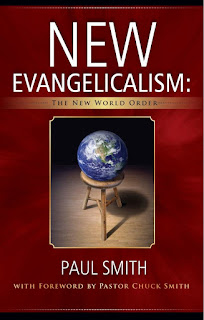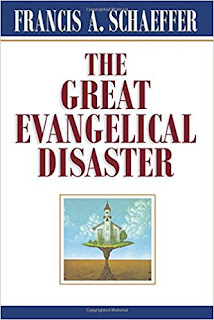Truths We Believe About God, Part 11
Conclusion: Part 1
A Biblical & Theological Rejection of Wm. Paul Young’s
book Lies We Believe About God*
—Emphasis added, Jeremiah 23:16-17, NKJV
Evangelical Anarchy & Chaos
Wm. Paul Young admits The Shack is a story, but that it’s wrapped in theology. Readers are thus challenged to discover the theology behind The Shack, and this has been the purpose of my interaction with Young’s book Lies We Believe About God. “Strictly, theology is that which is thought and said concerning God.”[111] So what does Young think and communicate about God? What is his theology which underlies Young’s writings?
It has been demonstrated that God’s Word is not core to Young’s beliefs. The assumption of Young’s big story, one contradicting Scripture, is that God is reconciled to everybody and everybody’s reconciled to God—that from time immemorial all people either now have or will develop a loving relationship with God. That The Shack has sold upwards of twenty-two million copies and the movie has attained star status indicates the “feel good” message of Universalism has become popular among evangelical Christians. So what’s going on here? It all begins with authority because theology is based on authority, on God’s Word, the Bible.
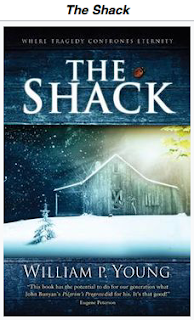 |
| (Source) |
Pan-Evangelicalism
As they look at the development of American pan-evangelicalism over the last decades, conservative Christians try to understand and explain the phenomena of both the book (2007) and movie The Shack (2017). Beliefs that were subtly implied and peddled by author Wm. Paul Young in The Shack are now openly declared in his non-fictional work Lies We Believe About God, in which he claims to expose lies commonly accepted as truths among evangelicals. To expose the twenty-eight lies he believes plague evangelicalism’s collective psyche, the author cleverly frames arguments around his impressions, experiences, conversations, questions, misrepresented Bible verses, and personal convictions. In his “conversation” with his readers, he intends for his core beliefs to influence theirs and that they too will reject lies they believe about God. After all, if what he exposes are really lies, shouldn’t readers embrace Young’s truths?
So as he wrote The Shack to explain to his children what he had grown to believe about God, ten years later he’s written a sort-of-theology Lies We Believe About God to make credible what he believes about God to his followers. Many pastors and Christian leaders have spoken out and written against The Shack, and their criticism has not been well received by those who love the book and movie.
Universalism Undeterred
Wayne Jacobsen, who collaborated with Young in writing writing The Shack, did so knowing that Young’s belief in universal reconciliation not only contradicted what he believed about salvation but also would offend, at least initially, mainstream evangelicals who possessed a superficial and cultural acquaintance with the Gospel. So Jacobsen attempted to help Young clean up obvious and offensive references to Universalism the first manuscripts of The Shack. Through their discussions, Jacobsen thought he had influenced Young to move away from Universalism toward a more traditional view of salvation, and in the editing process overt evidences of Young’s Universalism became obscured. Thus when critics arose who rejected the book’s humanization of God and undertones of Universalism, Jacobsen pejoratively labeled them hostile conspirators and defended both Young and his religious story-narrative-allegory he helped to edit. After all, criticism of Young was indirectly criticism of him. So one of the questions Jacobsen addressed to defend Young was: “Does The Shack promote Ultimate Reconciliation (UR)?”[112]
Jacobsen admitted the theme of universal reconciliation “was in earlier versions because of the author’s partiality at the time to some aspects of what people call UR,” but that both he and Young came to an understanding which he thought “affected” the author’s view of salvation. In other words, in the give and take of the editing process Young grew out of believing in UR. So Jacobsen excused Young as follows: “Holding him [Young] to the conclusions he may have embraced years earlier would be unfair to the ongoing process of God in his life and theology.”[113] So in answer to the question, “Does The Shack promote Ultimate Reconciliation (UR)?” Jacobsen categorically denied, “It does not.”[114] Yet a decade later in his book Lies We Believe About God, in refuting what he calls the lie “You need to get saved.” (Chapter 13), Wm. Paul Young “outs” his personal belief in Universalism. In the conversation he’s having with readers he writes,
Are you [Paul Young asks of himself] suggesting that everyone is saved?
That you believe in universal salvation?
That is exactly what I am saying!
This is real good news! (LWBAG, 118)
So as we look at what is happening in the religious conglomerate called evangelicalism, we ask, how has the movement grown so insensitive to the Gospel which it once accepted? That TBN (the Trinity Broadcasting Network) recently completed a 20 episode series “Restoring The Shack” featuring Wm. Paul Young, who also appeared on the Oprah show, indicates the authority of the evangel has been lost amidst entertainment.[115] As he rides the wave of celebrity, Young appears comfortable in peddling his synthesis of quasi Christianity and New Age and New Spiritual beliefs, and it appears that professing Christians are eating, or should I say buying, it up. So it must be asked, how did evangelicalism transition from Bible teachers like Dr. M.R. DeHaan (1891-1965) of the Radio Bible Class and Theodore Epp (1907-1985) of Back to the Bible to evangelists like Billy Graham (1918- ) and now to faith innovators like Wm. Paul Young (1955- )?[116] Did these early Bible teachers create a climate in which lies could flourish?
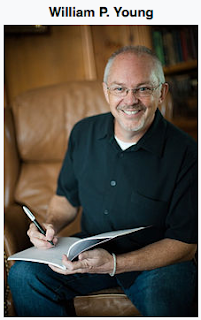 |
| (Source) |
A Question of Authority
“Ideas have consequences” is a phrase that has been often repeated, and nothing is more consequential and devastating to the Christian faith than thinking that one, the Bible, though it may contain the word of God or be a record of people’s experiences with God, is not the transcendently sourced inspired and authoritative Word from of God; and two, that the Scriptures are not determinative as to what Christians should believe, what they should not believe, how they should not behave, and how they should behave (2 Timothy 3:16). When Christians jettison the idea that Scripture’s authority without and external to themselves, spiritual anarchy results. Much group Bible study involves participants saying, I feel this verse means this or that. But the Bible means what it means and says what it says despite what I might personally think or feel. Preachers have popularly proclaimed, “The Bible says it, I believe it, and that settles it!” I would change this to: The Bible says it, that settles it! God’s Word is God’s Word independent of whether I believe it or not. If people believe whatever might suit a contemporary whim or fancy, and we fundamentalists and evangelicals are not immune from doing this, then what they believe about God is sourced within them, and such individualism is naturalism. Absent any coherence provided by the external authority of God in His Word, then everyman will believe and do whatever… whatever… they want. “In those days there was no king in Israel, but every man did that which was right in his own eyes” (Judges 17:6; 21:25). About such a condition of faith and life, D. Martyn Lloyd-Jones (1899-1981) wrote:
The choice for us today is really as simple as it was for those first Christians in the early days. We either accept this authority [i.e., The Scriptures] or else we accept the authority of ‘modern knowledge’, modern science, human understanding, human ability. It is one or the other.[117]
We, all of us, need to quit philosophizing and legalizing our faith and get back to God’s Word, the Lord Jesus Christ, the Gospel and the Bible!
God’s Immanence, God’s Transcendence
For centuries naturalism has asserted itself against Christianity in western civilization, and the church, more or less, buys into it. The Christian faith must be adapted to fit nature (i.e., the culture, society or science), and nature interprets and influences man’s understanding of God. Thus earth is viewed as the replica of heaven, “As above, so below.” (See John 8:21-24) God is viewed to be no longer transcendent over or independent of the material universe (dualism), but rather immanent and dependent upon the material universe (monism). When as promoted in The Shack, this monistic worldview becomes mainstream, then the biblical God and His truth fades into obscurity for as Francis Schaffer (1912-1984) said, nature will inevitably eat up grace. Whether at either the macro or micro levels, naturalism possesses zero tolerance for supernaturalism, the theistic evolution and deistic intelligent design movements being examples. So what’s the bottom line of this transcendence-immanence business? What’s the big deal? In a story he says is as old as history, and it is, Peter Jones frames the issue for evangelicalism: “Will we worship Nature or the God who created Nature?”[118]
So to understand the current state of affairs in contemporary evangelicalism one must be aware of naturalism’s influence upon the culture in general and Christianity in particular. To this end a general understanding of evangelical Christianity in America and how naturalism has influenced it might prove helpful.
 |
| (Source) |
The Condition of Chaos
Historically the theological lapse of Christianity from supernaturalism and order into naturalism and chaos might be summarized as follows. After the Pilgrim-Puritan Fathers settled in this land (1620-1691) and after the First (1730s through 1740s) and Second (Late 1790s to Mid 1800s) Great awakenings, there occurred in six interconnected and interacting movements: 1. The Rise of Liberalism (Mid to Late 1800s); 2. The Reaction of Fundamentalism and Evangelicalism (Early to Mid 1900s); 3. The Rejection of Fundamentalism by Neo-Evangelicals (Mid to Late 1900s); 4. The Romancing of Evangelicalism by early Pentecostalism and then the Charismatic movement (Early 1900s to Present); 5. The Repackaging of Evangelicalism by the Mega-Church Movement (Late 1970s to Present); and 6. The Restructuring of Evangelicalism by the Emergent Church Movement (Early 2000s to Present). The historical phases were and are….
Rationalizing the Message—Liberalism
In their attempt to remain relevant to a changing culture during the mid to late 1800s, major Protestant seminaries, denominations and pastors began adjusting their message to suit a determinative naturalistic-scientific worldview influenced by the acceptance, whether in part or the whole, of evolutionary theory. Trying to keep in step with the scientific elite and materialistic culture, liberals jettisoned belief in the “embarrassing” creation account of Genesis in favor of viewing the opening chapters of the Bible to be myth. As a result and given the interconnectedness of the rest of the Bible with Genesis, other biblical and supernatural beliefs began to fall like dominoes. Denominational hierarchies grew out of touch with some of their membership who remained Bible believers. Where could these believers go to find fellowship with others of like precious faith?
Reacting to Liberalism—Fundamentalism and Evangelicalism
So across denominational lines these believers sought the encouragement from and with others of like-minded faith. Their fellowship centered upon five essential and supernatural fundamentals of the faith to which they agreed—the inspiration, inerrancy and authority of the Bible, Jesus’ virgin-birth and incarnation, His substitutionary atonement on the Cross for sin, His physical resurrection from the dead, and His promised personal return to earth. This rejection of naturalism by Bible believers was called “fundamentalism.” That the movement attracted a significant number of followers became evidenced by the Bible conferences that were held and the Bible believing seminaries (Westminster, Dallas, Fuller, etc.), colleges, churches, independent faith missions and publishing houses that were founded. Because of its emphasis upon the Gospel (good news, the evangel, Greek euangelion), this network of independent fundamental Christians and institutions also became known as “evangelicalism.” Bible believers found a home in which naturalism did not oppress their faith, and for about fifty years all seemed to go well.
Reservations about Fundamentalism—the Neo-Evangelicals
After World War II during the late 1940s through the 1960s, a spirit of discontent settled over some evangelicals (traditional fundamentalists were not similarly disaffected). Tired with some of the movement’s censorious attitude toward liberal Christians and Roman Catholics along with its disregard for advancements in science (evolutionary theory, quantum physics, etc.), in biblical scholarship (historical and higher criticism regarding the origin and authorship of the biblical books) and the need to be socially relevant (the social gospel, i.e., “WWJD”), evangelical leaders and scholars began to distance themselves from separatistic and “narrow minded” fundamentalists and their churches and institutions. This protest movement became known as New or Neo-Evangelicalism.
Generally, new-evangelicalism de-emphasized the local church and founded parachurch ministries to compensate for what they thought were the fundamentalism’s deficiencies, ministries such as the Billy Graham Evangelistic Association, Christianity Today magazine, Youth for Christ International, Campus Crusade for Christ, Christian publishing houses, etc. With varying emphases, some biblical and others not, most of these ministries remain within evangelicalism today. But philosophical naturalism with its emphasis upon rationalism and evolutionary theory, continues to influence the collective mind and soul of the evangelical movement both from within and without. The world, always the enemy of God, continues to exert pressure upon Christians to conform (1 John 2:15-17). And not immune from these pressures, evangelicalism continued to host naturalism. As such, evangelicals no longer felt in their hearts that which their minds no longer believed.
Reviving the Message—the Charismatics!
Parallel with the rise of Neo-Evangelicalism, first the Pentecostal (Early 1900s to the Present) and then the Charismatic (Middle 1900s to Present) movements influenced the soul of evangelicalism in America. By the rousing up emotion for Jesus, the Charismatic movement with its emphasis upon supernatural “signs and wonders” revived feelings of faith which since the days of the manipulative evangelist Charles G. Finney (1792-1875) had lain dormant because of naturalism’s intrusion upon the collective evangelical mind and soul. These movements remain viable and influential among persons considering themselves to be evangelicals. But despite the influence of these movements, the 60s generation, “the baby boomers,” grew to feel disconnected from the traditional church religion their parents passively and nominally embraced.
Repackaging Church—the Church Growth Movement
So new strategies and methods of doing church were conceived during the 1970s and 80s in institutions like Fuller Seminary and its connection with Leadership Network, and by leaders such as C. Peter Wagner (1930-2016) and management consultant Peter Drucker (1909-2005), methods designed within a naturalistic framework to produce predictable results, namely church growth. So evangelicalism was repackaged to attract the bored-with-traditional-church crowd of “baby boomers.”
The church growth movement revised church “worship” to accommodate the contemporary tastes of those born during the late 1940s through the 1960s, accommodations which included entertaining worship teams performing upbeat rock music accompanied by special effects, cultivating a casual atmosphere by encouraging people to dress informally and providing coffee, communicating psychologized messages designed to meet people’s “felt needs” and make them feel good about themselves, and providing full service ministries for the whole family. In the church growth movement the consumer became king and influential pastors, taking their cues from Bob Schuller (1926-2015), conceived of doing church the “Purpose Driven” (Rick Warren) and “Willow Creek” (Bill Hybels) ways, both of which employed “tricks of the trade” learned from the master maestro of “The Crystal Cathedral.” (By the way, The Crystal Cathedral is no more. It went bankrupt.) Churches became “welcome centers” employing user-friendly management techniques and schmoozing-seeker-sensitive messages to reach the disconnected generation of “baby boomers” who felt the church to be irrelevant to the materialistic and well-adjusted life they wanted and pursued, and on the surface at least, the new management, method and message appears to have worked, especially in affluent suburbia America. Manipulate… manipulate… manipulate….
Evangelicalism in Chaos
This confusing, incoherent, chaotic and disparate mix (i.e., Traditional Fundamentalists, Evangelicals, Neo-evangelicals, Dispensationalists, Reformed, Calvinists, Neo-Calvinists, Open Theists, Pentecostals, Charismatics, the Jesus Movement, the Latter Rain Movement, the New Apostolic Reformation, Trinity Broadcasting Network followers, Evangelical Radio and Television Preachers, Evangelical Publishers, Fuller Theological Seminary, Leadership Network, Purpose Driven and Willow Creek, Contemplative Spirituality—Richard Foster, etc., the Emergent Church movement, and much more) I years ago referred to as “pan-evangelicalism.” By the way, though confusing on the surface, not everything in this mix is bad. Nevertheless, in one of his books Francis Schaeffer warned of The Great Evangelical Disaster.[119] We are now living in the disaster.
That many evangelicals have become disaffected by being part of the evangelical chaos and seek structure, stability and authority for their faith may be indicated by their defection into Eastern Orthodoxy or Roman Catholicism, the recent conversion of the Bible Answer Man’s Hank Hanegraaff into Orthodoxy being a case in point (many others like Thomas Howard, Elisabeth Elliot’s brother, and Frank Schaeffer, Francis Schaeffer’s son, preceded him).[120] James Stamoolis, who has written on the defection of evangelicals to “this older iteration of Christianity,” ascribes it to “the whole idea of authority,” and with the movement’s defection from believing in the inspiration and authority of the Bible, evangelicalism now espouses spiritual anarchy. So Stamoolis adds, “I know a lot of people who have converted from Protestantism to Catholicism and Orthodoxy because it’s fixed. It’s settled.”[121]
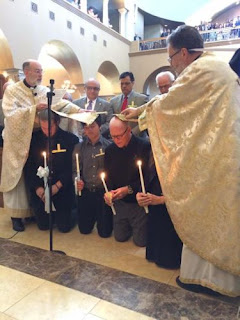 |
| Hank Hanegraaff became Orthodox (Source) |
Rescuing the Gospel—the Emergent Church
But as the entertainment phase of doing church wanes (it doesn’t take long for the bored to get bored again with the entertainment business called church), influential leaders and authors, who are really liberals, have arisen within the ranks of the evangelical movement. These individuals think and propose that change is again needed, that the aging, wrinkled and self-centered evangelical movement has grown out of touch with the needs of the world and had better get its act and message together or die and like an empty ship go drifting in the cultural sea of irrelevancy and obscurity. So to become relevant to our secularized culture, these voices view that evangelicalism doesn’t need another “face lift” (the mega-church has already tried doing that that), but a “mind lift.” Strong sentiment therefore exists in the emerging church that after decades of “lifts,” adjustments and readjustments, the church still hasn’t got the Gospel right.
As the mega-church movement centers upon methods, management strategies, music styles and psychologized preaching, the emergent church now attempts to adjust and adapt its message by creating a new “missional” narrative to fit an evolutionary “kingdom now” theology (which in its postmillennialism, denies the futuristic prophecies of Jesus, the prophets and the apostles). Thus, emergent church leaders focus upon such “now” issues as developing a sense community in the church (something lost in the mega-church), discovering a real, more authentic and more relevant historical Jesus, advocating a “green” worldview including an ecological message, and attending to social and political justice issues, communicating a more inclusive gospel message, and so forth. To get its message across, the emergent church attempts to create a new story to attract new believers from the crowd of secular skeptics and doubters like millennial youth who have grown to see “entertainment church” as being too self-centered to have any real impact on the modern world. (About this they are so right.)
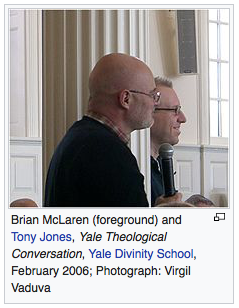 |
| (Source) |
Now that we have seen what has gone on in “the church of what’s happening now” we could ask, where might evangelicalism be going? My answer would be evangelicalism is going to go where it’s been going, and that’s deeper and deeper into naturalism and this philosophy’s inherent demand for pantheism, mysticism and universalism—that everything is spiritual, and that everyone is saved. The ingredients of naturalism are evident in Wm. Paul Young writings. He became the popular communicator of the new framing story coming out of the emergent church. He is on the cutting edge. Mark this also: When Young’s star begins to fade, and it will, someone else will assume the mantle of a false prophet. Someone else will arise to promote universalism. Nevertheless, into this evangelical chaos enter Wm. Paul Young and others…
Conclusion: Part 2 to follow…
Endnotes
[111] Geoffrey W. Bromiley, “Theology,” Baker’s Dictionary of Theology, Everett F. Harrison, Editor (Grand Rapids, MI: Baker Book House, 1960): 518.
[112] Wayne Jacobsen, “Is THE SHACK Heresy,” Life Stream, March 4, 2008 (https://www.lifestream.org/is-the-shack-heresy/).
[113] Ibid.
[114] Ibid.
[115] Wm. Paul Young, “Restoring the Shack,” TBN, Episodes 1-20, March 5-July 9, 2017 (https://www.tbn.org/people/wm-paul-young-0). See also interview by Oprah Winfrey of William Paul Young, “If Love Is Forced, That’s No Love at All,” SuperSoulSunday, Season 8, Episode 801, July 9, 2017 (http://www.oprah.com/own-super-soul-sunday/william-paul-youngif-love-is-forced-thats-no-love-at-all-video).
[116] There is also a glut of other popular entertainer-communicators who also played a role in the historical transition between historic evangelicalism and modernity, names like Peale, Schuller, Warren, Hybels, Osteen and more. See Pastor Larry DeBruyn, “Bewitched: Evil Eye Over Evangelicalism,” Discernment Newsletter, March/April 2010, Volume 21, Number 2 (http://www.discernment-ministries.com/Newsletters/NL2010MarApr.pdf). See also Paul Smith, New Evangelicalism: The New World Order (Costa Mesa, CA: Calvary Publishing, 2011). Paul has particularly insightful observations about Charles Fuller, the founding of the seminary bearing his name, and that seminary’s fall into modernism. See also Harold Lindsell, The Battle for the Bible (Grand Rapids, MI: Zondervan Publishing House, 1976): “The Strange Case of Fuller Theological Seminary,” 106-121, and “Other Denominations and Parachurch Groups,” 122-140.
[117] D. Martyn Lloyd Jones, Authority (Chicago, IL: Inter-Varsity Press, 1958); 60.
[118] Peter Jones, “Preface,” On Global Wizardry: Techniques of Pagan Spirituality and A Christian Response, Peter Jones, Editor (Escondido, CA: Main Entry Editions, 2010): 15.
[119] Francis A. Schaeffer, The Great Evangelical Disaster (Wheaton, IL: Crossway Books, 1984). “Have Christians compromised their stand on truth and morality until there is almost nothing they will speak out against? Has the evangelical church sold out to the world?” This is the question the book asks.
[120] Sarah Eekhoff Zylstra, “‘Bible Answer Man’ Converts to Orthodoxy: CRI’s Hank Hanegraaff joined the Greek Orthodox Church on Palm Sunday,” Christianity Today, April 12, 2017 (http://www.christianitytoday.com/news/2017/april/bible-answer-man-hank-hanegraaff-orthodoxy-cri-watchman-nee.html).
[121] “Why Orthodoxy Appeals to Hank Hanegraaff and Other Evangelicals,” Christianity Today, April 20, 2017 (http://www.christianitytoday.com/ct/2017/april-web-only/why-orthodoxy-appeals-to-hank-hanegraaff-and-other-evangeli.html).
*Read the previous articles in this series:
Part 1: Truths We Believe About God
Part 2: Doing the Universalist Twist
Part 3: OUR Way or THE Way?
Part 4: An Imaginary Cosmic Reality
Part 5: Universalism & Trinitization
Part 6: A Catena: The Chain of “All”
Part 7: A Catena: Universalism’s Troubles With “All”
Part 8: A Catena: Universalism’s “World” and “Everyone”
Part 9: A Catena: The “Catenization” of Universalism
Part 10: Pretending Evil Doesn’t Exist


